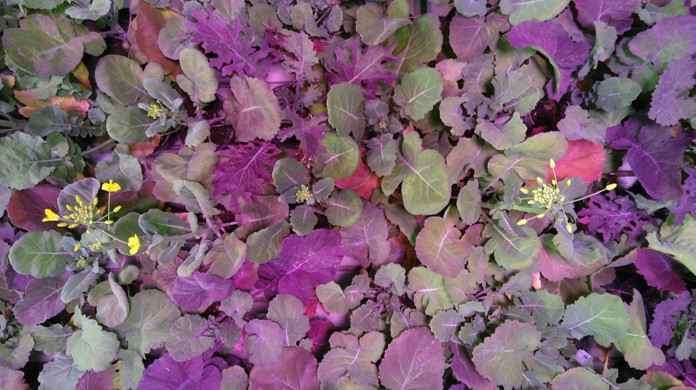Staff profile

| Affiliation | Telephone |
|---|---|
| Assistant Professor in the Department of Biosciences |
Biography
Research Focus

Current PhD opportunity: Watering the flowers: gene x environment control of water use during Brassica napus inflorescence development at Durham University on FindAPhD.com. Various funding opportunities available: contact me directly ASAP!
Plants survive large changes in temperature that occur every day, season to season. One of their survival strategies is to change their shape in response to their environment. For example, they may time the production and number of flowering branches to coincide with particular seasons, or produce leaves of different shape depending on the temperature they are growing at.
I am a plant developmental geneticist, and I am fascinated by the diversity of plant form both between individual plants and in an individual over its lifecycle. My research focusses on how plants sense and integrate real-world information, particularly cool temperature information, at the molecular level to make developmental decisions about whole-plant morphology. Understanding these responses is critical to predict the impact of climate change on agriculture, ecological networks, and to promote food security. I work with the model plant Arabidopsis thaliana and with Brassica crops; Brassica rapa, Brassica oleracea and Brassica napus. These crops are grown in many different climates and come in wide variety of shapes, from turnips to pak choi in B. rapa, oilseed rape to kales in B. napus, and broccoli, cauliflower and cabbage in B. oleracea. I am exploiting this wide phenotypic diversity to elucidate genetic pathways via multi-disciplinary approaches, including genetics, imaging, mathematical modelling, and both lab and field experiments.
Want to join the Cool Cabbage Lab? Funded PhD and MRes projects will be advertised on FindAPhD.com or FindAMasters.com (search for Jo Hepworth), and for more info, self-funded opportunities or postdoc fellowship support, email me direct.
Publications
Journal Article
- Maple, R., Zhu, P., Hepworth, J., Wang, J.-W., & Dean, C. (2024). Flowering time: from physiology, through genetics to mechanism. Plant Physiology, 195(1), 190–212. https://doi.org/10.1093/plphys/kiae109
- Jones, D. M., Hepworth, J., Wells, R., Pullen, N., Trick, M., & Morris, R. J. (2024). A transcriptomic time-series reveals differing trajectories during pre-floral development in the apex and leaf in winter and spring varieties of Brassica napus. Scientific Reports, 14(1), Article 3538. https://doi.org/10.1038/s41598-024-53526-x
- Calderwood, A., Hepworth, J., Woodhouse, S., Bilham, L., Jones, D., Tudor, E., Ali, M., Dean, C., Wells, R., Irwin, J., & Morris, R. (2021). Comparative transcriptomics reveals desynchronisation of gene expression during the floral transition between Arabidopsis and Brassica rapa cultivars. https://doi.org/10.1017/qpb.2021.6
- Calderwood, A., Lloyd, A., Hepworth, J., Tudor, E., Jones, D., Woodhouse, S., Bilham, L., Chinoy, C., Williams, K., Corke, F., Doonan, J., Ostergaard, L., Irwin, J., Wells, R., & Morris, R. (2021). Total FLC transcript dynamics from divergent paralogue expression explains flowering diversity in Brassica napus. New Phytologist, 229(6), 3534-3548. https://doi.org/10.1111/nph.17131
- Zhao, Y., Zhu, P., Hepworth, J., Bloomer, R., Antoniou-Kourounioti, R., Doughty, J., Heckmann, A., Xu, C., Yang, H., & Dean, C. (2021). Natural temperature fluctuations promote COOLAIR regulation of FLC. https://doi.org/10.1101/gad.348362.121
- Hepworth, J., Antoniou-Kourounioti, R., Berggren, K., Selga, C., Tudor, E., Yates, B., Cox, D., Harris, B., Irwin, J., Howard, M., Säll, T., Holm, S., & Dean, C. (2020). Natural variation in autumn expression is the major adaptive determinant distinguishing arabidopsis flc haplotypes. eLife, 9, 1-30. https://doi.org/10.7554/elife.57671
- Jarad, M., Antoniou-Kourounioti, R., Hepworth, J., & Qüesta, J. (2020). Unique and contrasting effects of light and temperature cues on plant transcriptional programs. Transcription, 11(3-4), 134-159. https://doi.org/10.1080/21541264.2020.1820299
- Antoniou-Kourounioti, R., Hepworth, J., Heckmann, A., Duncan, S., Qüesta, J., Rosa, S., Säll, T., Holm, S., Dean, C., & Howard, M. (2018). Temperature Sensing Is Distributed throughout the Regulatory Network that Controls FLC Epigenetic Silencing in Vernalization. Cell Systems, 7(6), 643-655.e9. https://doi.org/10.1016/j.cels.2018.10.011
- Hepworth, J., Antoniou-Kourounioti, R., Bloomer, R., Selga, C., Berggren, K., Cox, D., Collier Harris, B., Irwin, J., Holm, S., Säll, T., Howard, M., & Dean, C. (2018). Absence of warmth permits epigenetic memory of winter in Arabidopsis. Nature Communications, 9(1), https://doi.org/10.1038/s41467-018-03065-7
- Hepworth, J., & Dean, C. (2015). Flowering locus C’s lessons: Conserved chromatin switches underpinning developmental timing and adaptation. Plant Physiology, 168(4), 1237-1245. https://doi.org/10.1104/pp.15.00496
- Hepworth, J., & Lenhard, M. (2014). Regulation of plant lateral-organ growth by modulating cell number and size. Current Opinion in Plant Biology, 17(1), 36-42. https://doi.org/10.1016/j.pbi.2013.11.005
- Cardoso, C., Zhang, Y., Jamil, M., Hepworth, J., Charnikhova, T., Dimkpa, S., Meharg, C., Wright, M., Liu, J., Meng, X., Wang, Y., Li, J., McCouch, S., Leyser, O., Price, A., Bouwmeester, H., & Carolien, R.-S. (2014). Erratum: Natural variation of rice strigolactone biosynthesis is associated with the deletion of two MAX1 orthologs (Proceedings of the National Academy of Sciences of the United States of America (2014) 111 (2379-2384) DOI: 10.1073/pnas.1317360111). Proceedings of the National Academy of Sciences, 111(17), https://doi.org/10.1073/pnas.1405730111
- Zhang, Y., van Dijk, A., Scaffidi, A., Flematti, G., Hofmann, M., Charnikhova, T., Verstappen, F., Hepworth, J., van der Krol, S., Leyser, O., Smith, S., Zwanenburg, B., Al-Babili, S., Ruyter-Spira, C., & Bouwmeester, H. (2014). Rice cytochrome P450 MAX1 homologs catalyze distinct steps in strigolactone biosynthesis. Nature Chemical Biology, 10(12), 1028-1033. https://doi.org/10.1038/nchembio.1660
- Cardoso, C., Zhang, Y., Jamil, M., Hepworth, J., Charnikhova, T., Dimkpa, S., Meharg, C., Wright, M., Liu, J., Meng, X., Wang, Y., Li, J., McCouch, S., Leyser, O., Price, A., Bouwmeester, H., & Ruyter-Spira, C. (2014). Natural variation of rice strigolactone biosynthesis is associated with the deletion of two MAX1 orthologs. Proceedings of the National Academy of Sciences, 111(6), 2379-2384. https://doi.org/10.1073/pnas.1317360111
- Challis, R., Hepworth, J., Mouchel, C., Waites, R., & Leyser, O. (2013). A role for More Axillary Growth1 (MAX1) in evolutionary diversity in strigolactone signaling upstream of MAX2. Plant Physiology, 161(4), 1885-1902. https://doi.org/10.1104/pp.112.211383
- Crawford, S., Shinohara, N., Sieberer, T., Williamson, L., George, G., Hepworth, J., Müller, D., Domagalska, M., & Leyser, O. (2010). Strigolactones enhance competition between shoot branches by dampening auxin transport. Development, 137(17), 2905-2913. https://doi.org/10.1242/dev.051987

